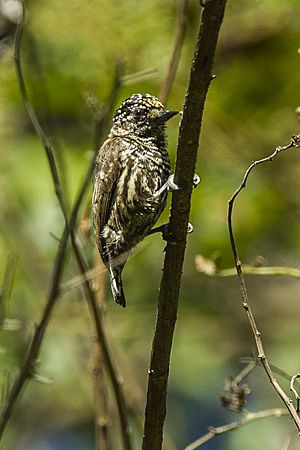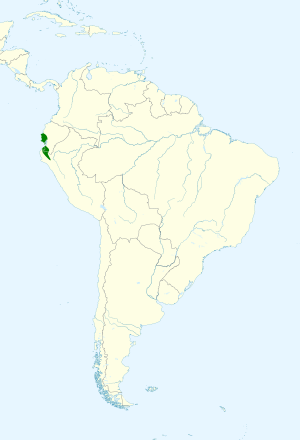Ecuadorian piculet facts for kids
Quick facts for kids Ecuadorian piculet |
|
|---|---|
 |
|
| Conservation status | |
| Scientific classification | |
| Genus: |
Picumnus
|
| Species: |
sclateri
|
 |
|
The Ecuadorian piculet (Picumnus sclateri) is a small bird that belongs to the woodpecker family. It lives in parts of Ecuador and Peru. These birds are known for being quite small, even for woodpeckers!
Contents
What is a Piculet?
Piculets are tiny woodpeckers. They are part of the Picidae family, which includes all woodpeckers. Unlike bigger woodpeckers, piculets usually have soft tail feathers. This means they can't use their tails to prop themselves up on tree trunks. Instead, they often perch on thin branches.
Meet the Family: Subspecies
The Ecuadorian piculet has three main types, called subspecies. Think of them like different versions of the same bird, each with small differences.
- P. s. sclateri
- P. s. parvistriatus
- P. s. porcullae
One of these, P. s. parvistriatus, was once thought to be a completely different species. But now, scientists agree it's a subspecies of the Ecuadorian piculet.
What Does It Look Like?
The Ecuadorian piculet is a tiny bird, about 9 to 10 centimeters (3.5 to 4 inches) long. It weighs around 10 to 12 grams (0.35 to 0.42 ounces), which is about the weight of two quarters!
Male and Female Birds
Adult male piculets have a black cap on their head. They have tiny yellow spots on their forehead and small white spots on the rest of their cap. Their back is gray-brown with faint darker stripes. Their tail is mostly blackish, but the inner feathers have white parts. The outer tail feathers also have a white area near the tip. Their belly is whitish with black or dark stripes on the chest and sides.
Female piculets look almost the same as males. The only difference is that their entire cap has whitish spots, not just the back part.
Differences in Subspecies
- P. s. parvistriatus has bigger white spots on its head than the other types. Its stripes on the belly are also much thinner.
- P. s. porcullae has pale beige streaks on its upper body. Its belly has black stripes, but very few or no streaks.
Where Does It Live?
The Ecuadorian piculet lives in specific areas of Ecuador and Peru.
Location of Subspecies
- P. s. parvistriatus lives in western Ecuador. You can find it from Manabí Province to northern Guayas Province. Its home is separate from the other two subspecies.
- P. s. sclateri lives in southwestern Ecuador. This includes El Oro and Loja provinces. Its range extends south into the very northwestern part of Peru.
- P. s. porcullae is found in northwestern Peru. It lives in the Piura and Lambayeque departments.
Favorite Places to Live
These piculets mostly live in forests where trees lose their leaves in certain seasons. They also like dry, scrubby areas. In Loja, Ecuador, they can also be found in places that are a bit more humid.
They live at different heights above sea level. In Ecuador, they are found from almost sea level up to about 1,700 meters (5,600 feet). Most of them live below 800 meters (2,600 feet). In Peru, they can be found up to 1,800 meters (5,900 feet), but most live below 1,200 meters (3,900 feet).
How Does It Behave?
What It Eats
The Ecuadorian piculet mainly eats very small insects. Scientists don't know all the details of its diet yet. It actively searches for food on thin branches. It picks and taps the branches to find its insect meals.
How It Acts with Others
You usually see the Ecuadorian piculet alone or in pairs. Sometimes, you might spot them in small groups, which could be families. They often join up with loose groups of other small passerine birds. Passerine birds are often called "perching birds."
When It Has Babies
The breeding season for the Ecuadorian piculet is from July to September in Ecuador. In Peru, it's from June to September. Not much else is known about how they raise their young.
What Sounds Does It Make?
The Ecuadorian piculet is described as "rather quiet." However, it does have a song. It's a slow series of notes that go down in pitch. It usually has three notes, but sometimes up to seven. It sounds like swee swee swee.
It also makes a high-pitched sound like tseee-tsut or tseeet. Another sound it makes is a quick, stuttering series, like tititi-swee.
Is It in Danger?
The IUCN (International Union for Conservation of Nature) has looked at the Ecuadorian piculet. They have assessed it as "Least Concern." This means it's not currently in danger of disappearing.
Even though it lives in a small area, its population seems to be stable. Scientists don't know the exact number of these birds, but they believe the population is not decreasing. There are no immediate threats that have been found.
The bird is described as uncommon in both Ecuador and Peru. Human activities don't seem to have a big direct effect on the Ecuadorian piculet in the short term. The main impact is when their habitat (the places they live) is destroyed.
See also
 In Spanish: Carpinterito Ecuatoriano para niños
In Spanish: Carpinterito Ecuatoriano para niños


